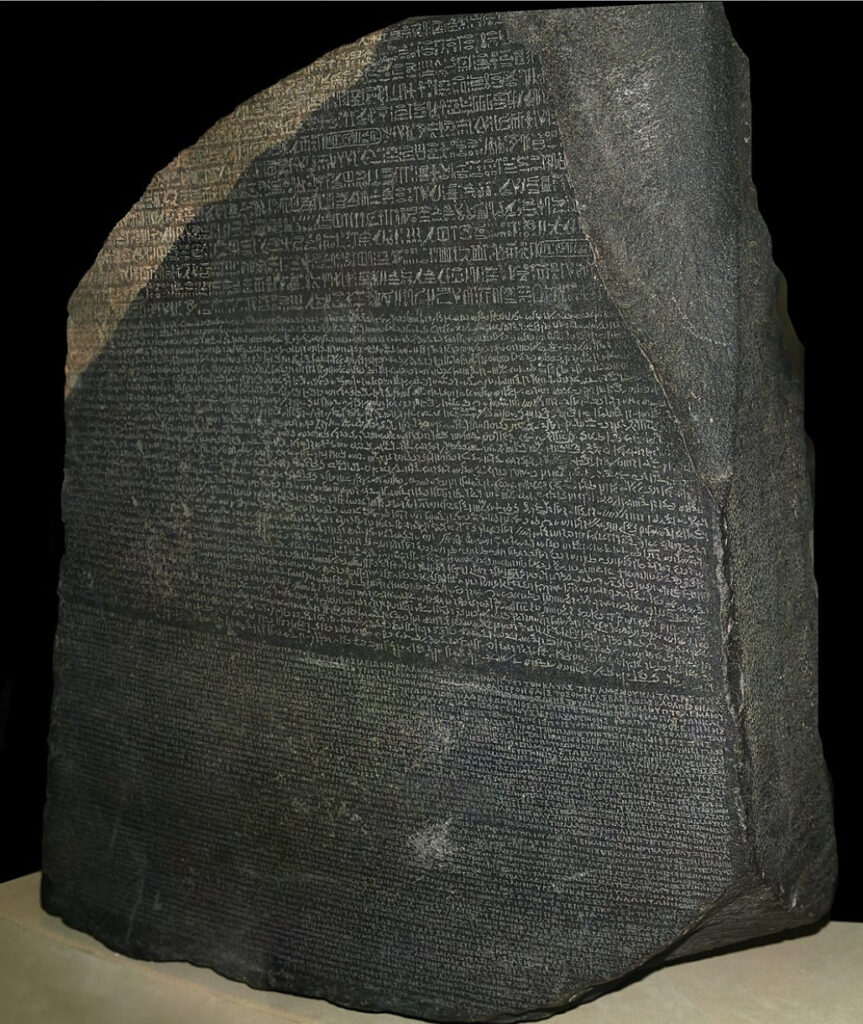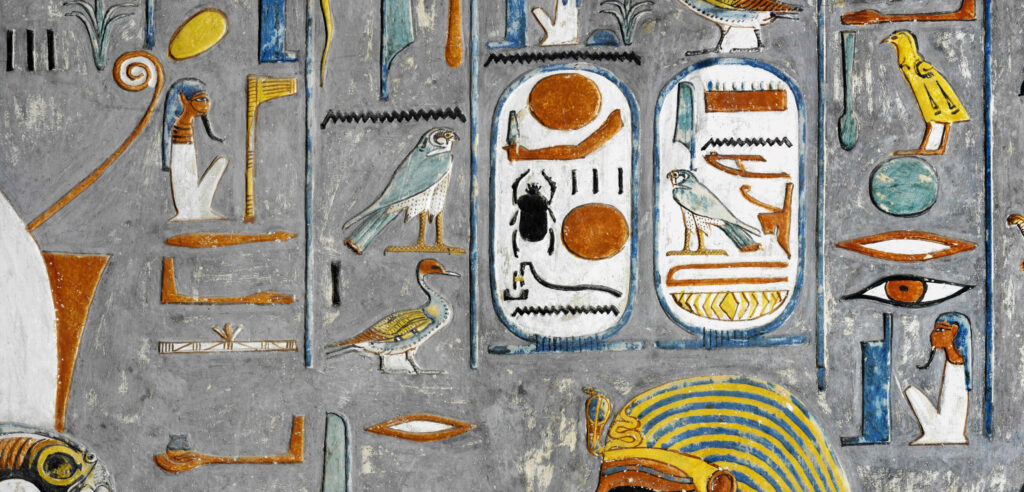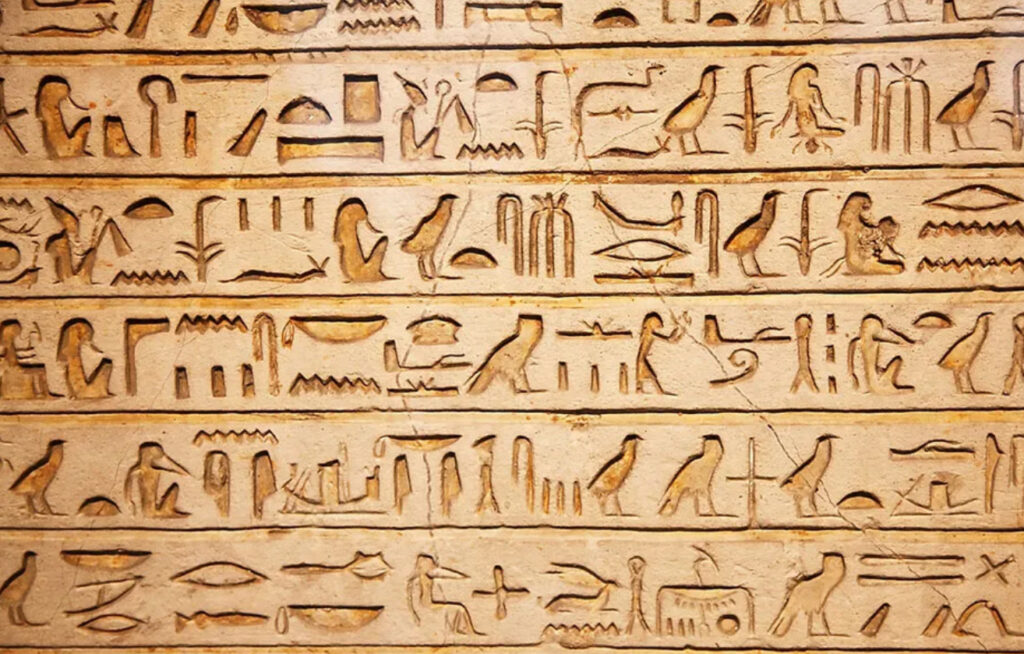ChatGPT:
1822: The Deciphering of Hieroglyphs
The deciphering of hieroglyphs by Jean-François Champollion in 1822 represents one of the most significant breakthroughs in the study of ancient civilizations. This achievement not only unlocked the mysteries of Egyptian hieroglyphs but also gave scholars unprecedented access to the culture, religion, and history of one of the world’s oldest civilizations. By unraveling the complexities of the Egyptian writing system, Champollion laid the foundations for the field of Egyptology, a discipline that continues to thrive and deepen our understanding of ancient Egypt.
In this extended summary, we will explore the origins of hieroglyphic writing, the religious and cultural significance attached to it, the challenges faced by scholars in deciphering the script, and how Champollion’s work revolutionized our understanding of ancient Egypt.
🌍 Origins and Power of Hieroglyphic Writing
Egyptian hieroglyphs emerged around 3200 BC, during a time of significant urban and administrative development. Alongside Sumerian cuneiform, Egyptian writing developed independently, but its importance was deeply intertwined with religious, political, and economic power.
In ancient Egypt, writing was perceived as a divine gift from the god Thoth, the deity of knowledge and writing. Hieroglyphs, known as “medu netjer” or “divine words” in Egyptian, were considered sacred and endowed with magical power. The act of writing something down brought it into existence, imbuing it with permanence. This was especially significant in religious contexts, where written names of individuals ensured their continuity in the afterlife.
The Egyptian worldview placed immense importance on the written word, so much so that writing became a crucial tool in maintaining not just social order but also the metaphysical balance of the universe. As such, the role of scribes was highly prestigious; those who controlled the written word held both secular and divine power. This idea is captured in the saying: “Whoever knows how to write has power.”
🏛️ The Performative Power of Words and the Afterlife
One of the most fascinating aspects of Egyptian hieroglyphs is their “performative” function, where language does not just describe reality but actively shapes it. This belief was central to the religious practices of ancient Egypt. For example, when priests recited spells or incantations from funerary texts like the Book of the Dead, they believed these words had the power to influence the deceased’s fate in the afterlife.
The Book of the Dead, or Chapters of Coming Forth by Day, was designed to guide the soul of the deceased safely through the dangers of the underworld. Its importance lay in ensuring continuity of existence beyond death. Egyptians were less obsessed with death than with the idea of “not disappearing”—as long as the name of the deceased was written down, they would continue to exist. This performative power was so great that pharaohs would sometimes erase the names of their predecessors to effectively obliterate their existence from history.
📚 The Evolution of Egyptian Writing
While hieroglyphs were used mainly for religious and monumental inscriptions, other forms of writing were developed for everyday use. Hieratic, a cursive version of hieroglyphs, emerged for more rapid writing. It was used primarily for administrative documents, contracts, and letters. Later, Demotic script, a simplified form of hieratic, evolved and became the standard for legal and economic texts during the later periods of Egyptian history.
These scripts reflect the practical needs of a complex society. From royal decrees to everyday transactions like “I will lend you my donkey in exchange for harvest days,” writing permeated all aspects of Egyptian life. Yet despite the widespread use of writing, literacy was confined to a small elite, primarily scribes and priests. Most of the population remained illiterate, much like in other ancient societies.
🌅 The Decline of Hieroglyphic Writing
Hieroglyphic writing, closely tied to the religious institutions of Egypt, began to decline after Egypt was conquered by Rome. As Christianity spread through the Roman Empire, pagan practices, including the use of hieroglyphs, were gradually suppressed. Emperor Theodosius I’s decree in the late 4th century, which forbade pagan worship and led to the closure of temples, marked the final blow to hieroglyphic literacy.
By the end of the 4th century, the last known hieroglyphic text was carved on the temple of Philae. As Egyptian religion and the use of hieroglyphs disappeared, the language became incomprehensible. For over a millennium, scholars and travelers marveled at the strange symbols without understanding their meaning.
🗝️ Early Attempts at Decipherment
Despite the gradual disappearance of hieroglyphic knowledge, several scholars in antiquity and the Middle Ages attempted to decipher the writing system. Greek and Roman authors like Herodotus and Strabo speculated on the meaning of hieroglyphs, believing them to be purely symbolic representations of ideas. This “symbolist” interpretation dominated European thought for centuries, creating significant obstacles to decipherment.
In the Renaissance, European scholars like Athanasius Kircher renewed efforts to decode hieroglyphs. Kircher made strides by proposing a relationship between Egyptian and Coptic, a descendant of the ancient language. However, his interpretations were often wildly inaccurate, as he approached hieroglyphs as a purely allegorical system.
🌟 The Rosetta Stone: A Breakthrough
The discovery of the Rosetta Stone in 1799 during Napoleon’s Egyptian campaign was a turning point. This stele contained the same text in three scripts: Greek, Demotic, and hieroglyphic. The presence of Greek, a well-understood language, provided scholars with a bilingual key that had long been missing. However, deciphering hieroglyphs was still a complex task. It was not until Jean-François Champollion’s intervention that the full potential of the Rosetta Stone was realized.

🔑 Champollion’s Breakthrough
Jean-François Champollion, a linguistic prodigy who studied over 30 languages, had a key advantage: his deep understanding of Coptic, the liturgical language of Egyptian Christians, which was derived from ancient Egyptian. Using the Rosetta Stone as a base, Champollion identified phonetic elements within the hieroglyphs, starting with the name “Ptolemy” and expanding to other names like “Cleopatra.”
Crucially, Champollion realized that hieroglyphs were a hybrid system, combining ideograms (representing ideas) and phonograms (representing sounds). This discovery allowed him to read both royal names and more complex inscriptions. In September 1822, he famously exclaimed, “I’ve got it!” upon deciphering the name “Ramesses,” marking the moment when the ancient script was finally understood after 1,500 years of obscurity.
🎓 Champollion’s Legacy: The Birth of Egyptology
Champollion’s decipherment of hieroglyphs was a monumental achievement that opened up a vast trove of knowledge about ancient Egypt. His work revealed the language behind the script and enabled the study of Egyptian history, religion, art, and daily life. This breakthrough gave birth to the field of Egyptology, allowing scholars to understand the writings of one of the world’s most advanced ancient civilizations.
Champollion’s method of comparing Egyptian writing with Coptic and Greek, combined with his determination and focus, allowed him to achieve what many before him could not. His achievement is considered one of the great intellectual breakthroughs of the 19th century, comparable to the discoveries of general relativity or the New World.
🏺 Decoding the Past: The Importance of Bilingual Texts
The Rosetta Stone played a critical role in deciphering hieroglyphs, but it also highlights a broader truth in linguistic studies: bilingual or trilingual texts are invaluable for unlocking the secrets of ancient languages. In the case of Egyptian hieroglyphs, the existence of Greek alongside Egyptian scripts provided the necessary link to crack the code.
However, not all ancient languages are so fortunate to have such tools. Many scripts remain undeciphered due to the absence of bilingual texts. Researchers studying languages like Etruscan or Meroitic face far greater challenges, often relying on guesswork and piecemeal findings to reconstruct meanings.
📖 Conclusion
The decipherment of hieroglyphs by Jean-François Champollion in 1822 marked a transformative moment in the study of ancient Egypt. Through his mastery of Coptic and his comparative study of the Rosetta Stone, Champollion unlocked the secrets of a civilization that had been lost to history for over a millennium. His work paved the way for modern Egyptology and deepened our understanding of one of the most influential cultures in human history.
Champollion’s achievement is not only a triumph of linguistic analysis but also a testament to the power of interdisciplinary study. His success underscores the importance of bilingual texts in unlocking ancient languages and the value of perseverance and focus in tackling seemingly insurmountable intellectual challenges.

Q&A (FAQs)
1. What was the significance of Jean-François Champollion’s decipherment of hieroglyphs?
Champollion’s decipherment in 1822 was a groundbreaking achievement that allowed scholars to read ancient Egyptian texts for the first time in over a millennium. This discovery opened up access to a vast body of knowledge about Egyptian religion, culture, history, and language, leading to the birth of Egyptology as a scientific discipline.
2. How did Champollion manage to decipher the hieroglyphs?
Champollion’s key advantage was his deep knowledge of Coptic, a language derived from ancient Egyptian. By comparing Coptic with the Egyptian texts on the Rosetta Stone, which also included Greek and Demotic scripts, he identified phonetic elements and developed a method to read hieroglyphs as a hybrid of ideograms (symbols representing ideas) and phonograms (symbols representing sounds).
3. What role did the Rosetta Stone play in the decipherment?
The Rosetta Stone, discovered in 1799, was crucial because it contained the same text written in Greek, Demotic, and hieroglyphic scripts. The Greek text, being well-understood, provided a key to comparing and deciphering the Egyptian scripts. This trilingual inscription served as the “bilingual key” Champollion needed to break the code.
4. Why had hieroglyphs remained undeciphered for so long?
For centuries, scholars misunderstood hieroglyphs as a purely symbolic or ideographic system, believing that each symbol represented a concept rather than phonetic sounds. This “symbolist” prejudice hindered progress in deciphering the script. Additionally, the Egyptian language had died out, and the knowledge of reading hieroglyphs had been lost after Egypt’s conversion to Christianity in the 4th century.
5. What types of writing systems did the ancient Egyptians use?
The Egyptians used three main writing systems:
• Hieroglyphs for religious and monumental inscriptions,
• Hieratic for administrative and daily texts (a cursive version of hieroglyphs),
• Demotic for more simplified, everyday writing, especially during later periods.
6. What is the connection between Coptic and ancient Egyptian?
Coptic is the last stage of the Egyptian language and was the liturgical language of Egyptian Christians. Champollion’s knowledge of Coptic was crucial for deciphering hieroglyphs, as it helped him recognize the phonetic elements in ancient Egyptian texts and connect them to modern sounds.
7. Why were hieroglyphs considered sacred in ancient Egypt?
Hieroglyphs, known in Egyptian as “medu netjer” (divine words), were believed to have magical powers. Writing something down was seen as bringing it into existence, and this belief extended to the afterlife. The Egyptians used writing in religious texts to ensure immortality and communicate with the gods.
8. How did hieroglyphs fall into disuse?
Hieroglyphs gradually fell out of use after Egypt came under Roman rule and Christianity spread. The closing of pagan temples in the 4th century AD by Emperor Theodosius I marked the end of hieroglyphic writing. The last known hieroglyphic inscription dates from 394 AD.
9. How did early scholars misunderstand hieroglyphs?
Greek and Roman scholars, such as Herodotus and Plato, believed hieroglyphs were purely symbolic and did not attempt to learn the system. In later centuries, this misconception persisted, with Renaissance scholars treating hieroglyphs as an esoteric or mystical script rather than a language with phonetic elements.
10. What was the impact of Champollion’s work on modern Egyptology?
Champollion’s work founded the field of Egyptology, enabling scholars to study Egyptian texts in their original form. His decipherment allowed for the translation of a wealth of religious, legal, and historical documents, providing a deeper understanding of ancient Egyptian society and culture.

